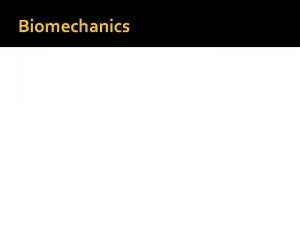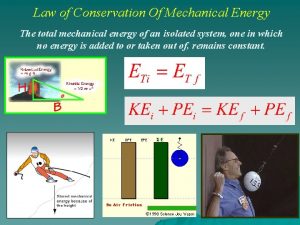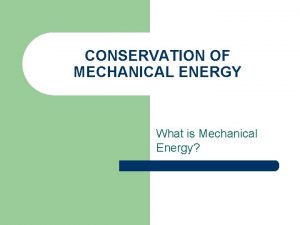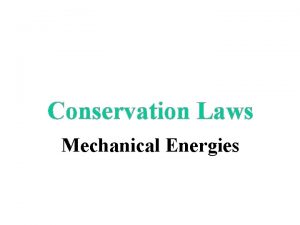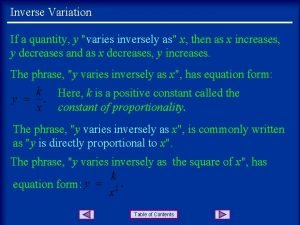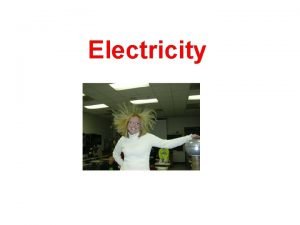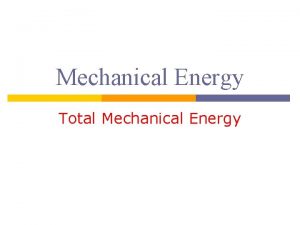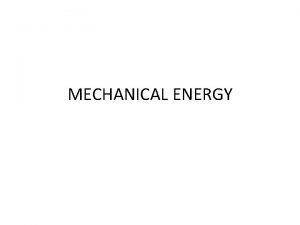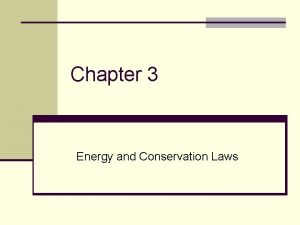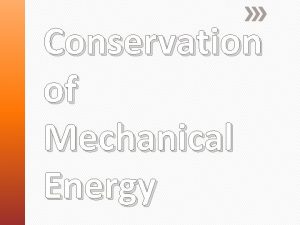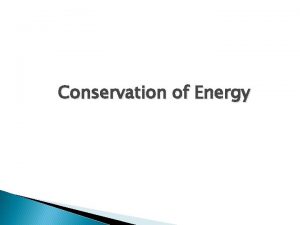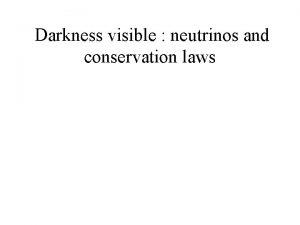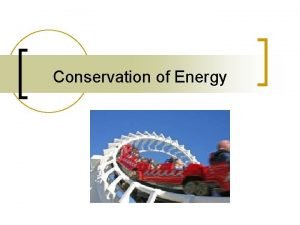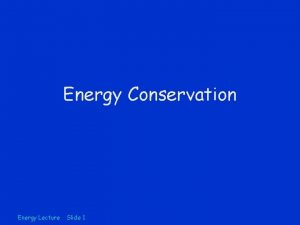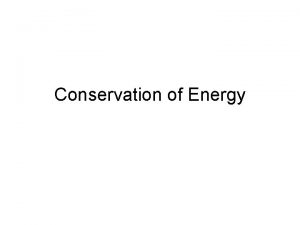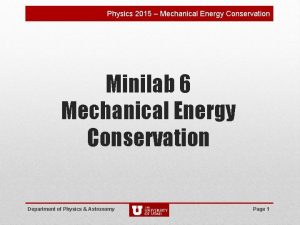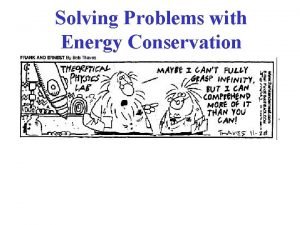Conservation Laws Mechanical Energies ENERGY A quantity possessed



















- Slides: 19

Conservation Laws Mechanical Energies

ENERGY A quantity possessed by an object that is associated with its motion, or its ability to move. CHARACTERISTICS • Energy CANNOT be created or destroyed. • Energy can transform from one type of energy to another. • Energy can transfer from one object to another. • Energy can move from one place to another. UNITS joule newton-meter kilogram-meter per second squared J N m kg m 2/s 2

OBJECT / SYSTEM / ENVIRONMENT OBJECT The mass being investigated. Examples A mass m A person A gas molecule SYSTEM A group of objects experiencing the same conditions/motion, and therefore acting as a single larger object. Examples Two or more masses tied together by a string An elevator car containing several people A mole of gas molecule ENVIRONMENT Everything else Examples The surface the mass is moving along The floors that the elevator moves between The cylinder and piston holding the gas

KINETIC ENERGY The energy of moving objects. • To possess this energy objects must have speed, v. • Kinetic energy can never be negative, v 2 = positive. • Energy is not a vector, and direction does not matter. If speed is doubled what is the effect on kinetic energy? It quadruples. If mass is doubled what is the effect on kinetic energy? It doubles.

POTENTIAL ENERGY Potential energy is the energy related to an object’s position. • Think of this as the potential to create kinetic energy. • To possess useful potential energy objects must be in a position where they are able to move. Testing for useful potential energy. Imagine the object paused. When the object is released from rest at this position, does it move? If yes, then it has useful potential energy.

GRAVITATIONAL POTENTIAL ENERGY To possess gravitational potential energy an object must have a height, h , relative to a location where energy is set as zero. • When released from a height h gravitational potential energy will convert into kinetic energy. • Height and potential energy can be negative, if the object is in a position below the location set as zero height. Negative height and its associated negative gravitational potential energy can be avoided if the lowest location during a problem is set as zero height. If this is done all height will be positive or zero. • Gravitational potential energy is directly proportional to height.

ELASTIC POTENTIAL ENERGY Elastic potential energy is the energy stored in spring like devices and depends on how far the device is compressed or stretched, x. • The spring constant k is unique to each elastic device. The greater the spring constant the more difficult it is to stretch or compress the elastic device. The spring constant is measured in newtons per meter (N/m). • When released from a displacement x elastic potential energy will be converted into kinetic energy. • Elastic potential energy can never be negative, x 2 = positive. • Elastic potential energy is proportional to the square of displacement, x 2 , and to the spring constant k.

Examples 1, 2, and 3 1. A spring with a spring constant of 20 N/m is stretched 10 cm. Determine the energy stored in the spring. 2. A 5 kg mass is 3 m above the ground. Determine the potential energy of the mass. 3. A 400 g mass is moving at 6 m/s. Determine the kinetic energy of the mass.

TOTAL MECHANICAL ENERGY Imagine the problem is being watched on a TV, and at a critical instant the pause button is pressed. While the action is paused measure the height, h , spring stretch/compression, x , and speed, v. Total mechanical energy is the sum of the potential and kinetic energies. Total mechanical energy is an instantaneous value.

Example 4 A 5. 0 kg mass is 6. 0 m above the ground and traveling at 2. 0 m/s. Determine the total mechanical energy. The complete equation includes all the mechanical energies. However, one or more of these energies might be zero. Look for the three key variables ( x , h , v ) to see which energies to include. In this problem only h = 6. 0 m and v = 2. 0 m/s are mentioned.

CONSERVATION OF ENERGY Energy cannot be created or destroyed. It can change forms. The first sentence implies that the total energy remains the same. We already have an equation for total mechanical energy. Conservation of energy means that the value of the total energy at any point 1 will be equal to the value of the total energy at any point 2.

CONSERVATIVE FORCES When conservative force act, the total energy stays with the object / system. Example A 2. 0 kg mass initially at rest is dropped from a height h = 5. 0 m. Determine the object’s speed v , when it strikes the ground. Set the lowest point in the problem as h = 0. m h=5 m Position 1: Location where information is known. h 1 = 5. 0 m x 1 = 0 (no spring involved) v 1 = 0 (initially at rest) Position 2: Location where information is sought. m h=0 v=? h 2 = 0 (strikes the ground) x 2 = 0 (no spring involved) v 2 = ? (Determine speed)

CONSERVATIVE FORCES When conservative force act, the total energy stays with the object / system. Example A 2. 0 kg mass initially at rest is dropped from a height h = 5. 0 m. Determine the object’s speed v , when it strikes the ground. h 1 = 5. 0 m x 1 = 0 v 1 = 0 m h=5 m m v=? h 2 = 0 x 2 = 0 v 2 = ?

PROBLEM SOLVING STRATEGY Use the overall concept equation as a guide to building a custome equation Select from the above menu of available energies to build your equations.

Example 5 h=4 m A 1. 0 kg mass, initially at rest, is dropped from a height of 4. 0 m, which is 2. 0 m above a spring ( k = 20 N/m). m h=3 m m h=2 m m h=1 m m h=0 m 20 0 Ug (1)(10)(4) = 40 (1)(10)(2) = 20 (1)(10)(1) = 10 0 Us 0 0 ½(20)(1)2 = 10 ½(20)(2)2 = 40 ΣE 40 40 K 0 20

Example 6 A projectile is launched with a speed of 30 m/s at an angle of 60 o. It lands on a hill that is 40 m tall. Determine the projectile’s impact speed. Position 1: Info is given (launch) No spring, x 1 = 0 Initial height is zero, h 1 = 0 m Launch speed, v 1 = 30 m/s Position 2: Info is sought (landing) No spring, x 2 = 0 Lands on hill, h 2 = 40 m Determine landing speed, v 2 = ?

Example 7 A mass m starts from rest at the top of a smooth, frictionless, quarter circle of radius r. The upper horizontal surface is a distance 2 r above the lower horizontal surface. Answer all parts in terms of r and g. m This is two separate problems. r 1. Conservation of energy. 2. Followed by projectile motion. Do them one at a time. 2 r Δx

Example 7 A mass m starts from rest at the top of a smooth, frictionless, quarter circle of radius r. The upper horizontal surface is a distance 2 r above the lower horizontal surface. Answer all parts in terms of m , r , and g. (A) Determine the speed of the mass when it reaches the bottom of the quarter circle. m Chose a convenient zero height line r m Position 1 Info known h 1 = r x 1 = 0 v 1 = 0 h=0 Position 2 Info needed h 2 = 0 x 2 = 0 v 2 = ?

Example 7 A mass m starts from rest at the top of a smooth, frictionless, quarter circle of radius r. The upper horizontal surface is a distance 2 r above the lower horizontal surface. Answer all parts in terms of m , r , and g. (B) Determine the horizontal distance Δx traveled by the blocks before striking the ground. m 2 r Δx
 Angular momentum biomechanics
Angular momentum biomechanics Formula for kinetic energy
Formula for kinetic energy Law of conservation of mechanical energy formula
Law of conservation of mechanical energy formula Mechanical energy definition
Mechanical energy definition Law of conservation of energy example
Law of conservation of energy example Law of conservation of energy
Law of conservation of energy Kinetic energy
Kinetic energy Efficiency equation
Efficiency equation Potential energy units
Potential energy units Scalar and vector quantities similarities
Scalar and vector quantities similarities Vector quantities
Vector quantities Why speed is a scalar quantity
Why speed is a scalar quantity Vary inversely
Vary inversely Scalar quantity and vector quantity
Scalar quantity and vector quantity Chapter 7 energy conservation of energy
Chapter 7 energy conservation of energy How to convert mechanical energy to electrical energy
How to convert mechanical energy to electrical energy Sample of mechanical energy
Sample of mechanical energy How does a motor work
How does a motor work Name things little kids hate family feud
Name things little kids hate family feud Possessed object access system
Possessed object access system
